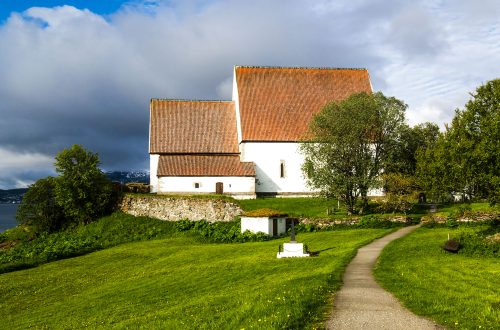
Naturhistorisk Museum Oslo
Kolejne muzeum i kulturalna atrakcja w stolicy Norwegii odhaczone. A tak na poważnie, to całkiem ciekawe miejsce i obowiązkowa rodzinna wycieczka, jeśli posiada się dzieci uwielbiające dinozaury (a które dzieci nie uwielbiają).
Muzeum Historii Naturalnej mieści się przy Sars’ Gate 1 i jest to raczej kompleks budynków otoczonych sporym parkiem lub jak kto woli ogrodem botanicznym. Całość, jakieś 2 kilometry na północny wschód od stacji Oslo S. W cenie biletu dostajemy wstęp na kilka wystaw:
– Wystawy geologiczne, w tym ewolucja roślin, zwierząt i człowieka; minerały i skały; historia Morza Północnego i Morza Barentsa, wiadomości o Układzie Słonecznym, Ziemi i meteorytach.
– Wystawy zoologiczne czyli: ptaki, norweska fauna, zagrożone gatunki i zwierząt z różnych zakątków świata.
– Ogród botaniczny – Tutaj akurat wstęp jest bezpłatny, a oprócz zieleni otaczającej teren muzeum znajdują się też dwa budynki: Palmiarnia oraz Victoriahuset.
– Klimahuset – wystawa poświęcona zmianom klimatycznym.
Budynek geologii to świetna lekcja historii naszej planety. Można poznać historię Ziemi, począwszy od kształtowania się pierwszych mikroorganizmów, grzybów i roślin. Niezwykłe, odciśnięte w kamieniu rośliny sprzed milionów lat, zrekonstruowane szkielety dinozaurów, skamieliny czy zęby prehistorycznego rekina, Megalodona to tylko niewielka część tej wystawy. To że robi ona ogromne wrażenie, jest lekkim niedopowiedzeniem. To ogrom informacji i niesamowitych eksponatów z całego świata, nie tylko z Norwegii.
Skały i minerały to kolejna sala w tym samym budynku. Jestem pod tym względem laikiem i nie orientuję się w temacie ale ta wystawa jest przeogromna. Ciągnące się kolejne gabloty z najróżniejszymi formami skał i olśniewających minerałów uświadomiły mi ogrom mojej ignorancji. Nie sądziłem, że na naszej planecie jest tyle różnych form kamieni i kryształów. I że potrafią one być tak zachwycające.
Dalej było równie ciekawie, choć przytłoczony dopiero co odkrytą wiedzą, nowych informacji nie chłonąłem już tak zawzięcie. Sala poświęcona historii morza oraz Układowi Słonecznemu również zasługuje na uwagę.
Drugi budynek związany jest z zoologią, spotykamy tu więc szkielet słonia i inne okazy zagrożonych wyginięciem zwierząt. Następnie przechodzimy przez kolejne sale ze scenkami norweskiej dzikiej przyrody i przedstawicielami lokalnej fauny oraz, na samym końcu poznajemy zwierzęta z całego świata.
Na zwiedzanie warto przeznaczyć nieco więcej niż dwie, trzy godziny bo ogarnięcie wszystkiego na raz może trochę potrwać. A wizyta z dziećmi może być świetną odskocznią od telewizji czy gier komputerowych.
Another museum and cultural attraction in the capital of Norway. Natural History Museum is quite an interesting place and a must-see family trip if you have kids who love dinosaurs (and which kids don’t).
The museum is located at Sars’ Gate 1 and it is rather a complex of buildings surrounded by a large park or, if you prefer, a botanical garden. The whole thing, about 2 kilometers northeast of Oslo S station. The ticket price includes admission to several exhibitions:
– Geological exhibitions, includes the evolution of plants, animals and human; minerals and rocks; history of the North Sea and the Barents Sea, information about the Solar System, Earth and meteorites.
– Zoological exhibitions: birds, Norwegian fauna, endangered species and animals from around the world.
– Botanical Garden – Here, admission is for free, and in addition to the greenery surrounding the museum area, there are also two buildings: Palm House and Victoriahuset.
– Klimahuset – an exhibition related to climate changes.
The geology building is a great lesson in the history of our planet. You can learn about the history of the Earth, starting with the formation of the first microorganisms, fungi and plants. Unusual plants from millions of years ago, reconstructed skeletons of dinosaurs, fossils or teeth of the prehistoric shark, Megalodon, are only a small part of this exhibition. It’s a lot of information and amazing exhibits from all over the world, not only from Norway.
Rocks and Minerals is another room in the same building. I’m a layman in this field and I don’t know much about this, but this exhibition is huge. Many display cases with various forms of rocks and amazing minerals made me realize the enormity of my ignorance. I had no idea that there were so many different forms of stones and crystals on our planet. And that they can be so delightful.
The rest was still interesting, although overwhelmed by the newly discovered knowledge, I did not absorb new information so fiercely. The room dedicated to the history of the sea and the solar system also deserves attention.
The second building is related to zoology, so here we can see the skeleton of an elephant and other specimens of endangered animals. Then we go through the next rooms with scenes of Norwegian wild nature and representatives of the local fauna and, at the very end, we get to know animals from around the world.
It is worth spending a little more than two or three hours on sightseeing because it may take a while to see everything at once. And a visit with children can be a great alternative for television or video games.




























